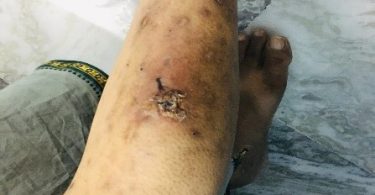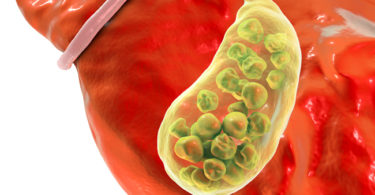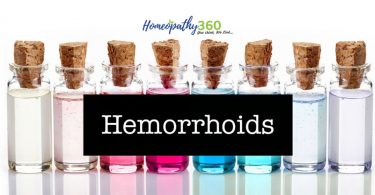Colic –severe pain resulting from periodic span in abdominal organ –spasmodic pain in abdomen due to stone in kidneys , ureter . the pain is commonly caused by stone which moves and irritates the urinary system and gives rise to pain which is classically described as “renal colic “ the pain is classically described as “loin to groin” pain . Usually it is abrupt in onset and begins in the renal flank area and courses down around the abdomen and then radiates to the groin and genitalia . this pain may last for minutes to hours followed by periods of relief . Nausea and vomiting may accompany the pain . Burning while voiding and frequent urge to void may occur as stone moves near the bladder . Foul smelling or cloudy urine , fever with chills and weakness may indicate associated infection which could result in more serious illness . Renal colic is an agonizing pain which is probably caused by muscular spasm of the renal pelvis and ureter . To be very precise and accurate , it is best to discard the term “ renal colic “ and speak of renal pain ureteric colic . renal pain is usually a dull ache situated mainly in the costo vertebral angle , but also in the upper and outer quadrant of the abdomen . renal pain is not strictly lumber (herpese zostr can also cause lumbar pain as often as renal)ureteric colic is nearly always characteristic in radiation is prolonged to the testis , which becomes retracted . A patient attacked with ureteric colic can often map out the course of this pain accurately for on the spot diagnosis during or soon after an attack of ureteric colic the pulse and temperature are normal . the abdomen moves on respiration on tenderness and guarding is felt but no true rigidity hperaeshesia may be there in severe cases
For the differential diagnosis of ureteric colic from appendicitis and intestinal colic , the patient should be asked to draw in the abdominal muscles and on doing so he experienced in the right iliac fossa in appendicitis but only discomfort in intestinal or ureteric colic . on asking the patient suddenly to let the muscles go slack , acute pain is experienced in appendicitis , but only discomfort in intestinal or ureteric colic , unilateral distribution of pain in ureteric colic and frequent deep tendrness along the line of ureter or over the kidney establishes the colic as ureteric and not intestinal .
Another valuable differentiating sign between the renal colic and acute appendicitis is on asking the patient cough and frequent coughing will cause pain in the right iliac fossa in acute appendicitis but it never does so in ureteric or renal colic . the renal colic must be differentiated from other varieties of abdominal colic and pain such as billiary and pancreatic colic also and from Diel’s crisis associated with a moveable kidney and kinging of the ureter from a twisted ovarian cyst or rarely from a tabetic crisis . Normally the X-rays show the presence for calculi , provided they contain a sufficiency of calcium other shadows such as caused by calcified glands and pheboliths must be excluded . ultrasound and IVP (intravenous pyelography ) is required in order to localize the shadow of calculi accurately . stone or calculi usually form around a colloid nucleus such as fibrin , mucopus cell debris and micro organisms preliminary calculi normally form in acid urine with any bacterial infection ; where as secondary calculi are deposited in alkaline kurine infected with organism , thus a phosphatic crust maybe formed around an uric acid nucleus . there are various types of stones or calculi such as :-
- uric acid –brown hard and irregular
- calcium oxalate (mubery calculus) –dark and irregular when formed in the bladder they are round , they may be dendritic when occurring in the renal pelvis , they are often mixed with calcium
- ammonium urate –hard and brownish
- triple phosphate –rather soft and smooth
- mixed or laminated calculi—they have an uric acid nucleus and a phosphating coating
- cystin –soft yellow , green radially laminated
- xanthine—radish brown
- indigo—blue and marks paper , it is derived from indol and is extremer rare
- calcium carbonate –smooth hara and dark grey
- urostealith—containing cholestrin
if the calculus remains in kidney substance there may be no symptoms or the patient complains of aching in the urine . if the stone obstructs the out flow of urine there is severe pain owing to stretching of the renal capsule . it normally occurs with a stone in the ureter and the pain is due to distension rather than the passage of stone along the ureter . the pain is due to distension rather than the passage of stone along the ureter . the pain ceases either when the kidney does not secrete more urine or when the obstruction is relieved . the pain is felt in the flank and may be referred to sound side it may also radiate to groin and inner side of the thigh . there is usually a sense of nausea and vomiting may occur .
renal colic pain is normally paroxysmal and radiate along the course of ureter to groin , hypogastrium and testicles and testis may be drawn . the patient is pale or flushed , sweats , rolls about in agony and may vomit . there is a frequent desire to micturate and the urine is scanty and may contain blood . the attack lasts usually from a few minutes to 2 hours , but it may be considerably longer . after an attack there is aching and tenderness in the loin .
though several attacks of renal colic are not infrequent , the major complications are due to
- infection resulting in pylelitis ,pyonephrosis renal atrophy and anuria if both kidneys are put of action
- obstruction producing hydronephorosis pyonephrosis renal atrophy and anuria if both kidneys are put out of action
- ulceration with extravesation of urine through the ureter a stricture may form subsequently .
- malignant disease affecting the kidney
In some cases only one attack of renal colic occurs but the prognosis is always serious as the calculi tend to recur even after the stone has passed or removed by surgical procedures or the latest ESWL (extractorporeal shock wave lithotripsy ) and PCNL(percutaheous ultra sonic nephrolithotripssy) URS (uretrorenoscopy) and of course with laser .
As such there is no single absolute theory known to mankind that leads to stone formation , the one that can be commonly explained is that of super saturation crystalisation theory , urine a super saturated solution has tendency to form crystals of some of the solids dissolved in it . these solids are particularly the salts of calcium ;oxalates phosphates urates are uric acid when concentration of these substances exceeds their solubility crystals are deposited , if these are not washed out with urine and are allowed to clamp together they form gravel . this forms the nucleus of stone and allows precipitation of further crystals , ultimately leading to stone formation . the stone is first formed in the calyces of the kidney but it may move out of it and lodge anywhere in the urinary tract
Though with homoeopathic appropriate constitutional remedies like ; calc carb , lycopodium , nux vomica ,phosphorous , and sulphur etc.,can check the recurrence of the stone and prevent the damage to the urinary tract system . I have seen few families in which the history of stones is so strong that almost all the family members have the stone at some stage or the other even the young children have suffered fro this problem interestingly I have seen a patient who has been passing small tiny stone almost every alternate months for the last so many years , after the homoeopathic treatment in which I gave his constitutional remedy the frequency of stone formation has reduced considerably .
Since urinary out put of calcium and of oxalates and urates which are common constituents of stones , depends more on androgynous metabolism than the exogenous sources . stones seldom consist of a single substance the dietary restriction of mixed stones present grave practical difficulties , still the elimination of spinach and rhubarb , plant with fleshy leaf stalks cooked as substitute for fruit , from the tilted articles is desirable , articles which contain very high content of oxalate may be restriction for liver , kidney sweet bread , fishery sardines and small sea fish is advisable as they have a very high purine content . since phosphoric calculi are found only in alkaline and urate acidifying the urine is desirable . solitarily cystine and urate stones may be prevented or dissolved by making the urine persistently alkaline , above all the most important therapeutic and prophylactic measure for all forms of stone is provision of an adequate fluid intake as it helps to flush out from the urinary passages particles of gravel which in time may develop into calculi . a daily out put of urine of at least 3 liters is advisable , hence intake of fluid should be approximately 4 liters daily intake daily in normal circumstances and for a patient of stone minimum intake of an adult should be around 30 glasses of water per day
Homoeopathicaly remedies are prescribed on the totality of symptoms and on the characteristic symptoms . commonly used remedies are –berberis vulg , hydrangia , terebinth , colocynthis , mag phos , nux vomica , lycopodium , apis mellifica , parera brav , oscimum etc.,
Berberis vulgaris —main remedy for renal colic especially when the pain is on the left side and extends from kidneys to urethra , with urging to urinate .
Lycopodium –in chronic cases when the acute pain is over , there is flatulence in abdomen specially right side with red sand in urine
Mag phos –colic , forcing patient to bend double , relieved by rubbing , warmth pressure accompanied with belching of gas which gives no relief
Colocynthis –tenermus of bladder , pains on urinating over whole abdomen agonizing cutting pain in abdomen causing patient to bend double and pressing on the abdomen . sensitive in the calves cutting I abdomen <anger and indignation> doubling up hard pressure
Causticum –excruciating pain which radiates from kidney to testicles . attack comes on while sleeping .
Hydrangia –remedy for gravel profuse deposits of white amorphous , salts in urine , calculus renal colic bloody urine acts on ureter , burning in ureture and frequent desire urine hard to start , sharp pain in loins specially left , spasmodic strictures also known as stone breaking remedy .
Calcarea carb –violent drawing pain in the region of kidneys white sediments , urine becomes turbid like clay water immediately after passing
Pareira brava –renal colic pain going down thighs constant urging great strining pain in the thighs during effort to urinate can pass urine only when he goes on his knees pressing hard firmly on the floor
Osciumum can – uric acid diathesis renal colic specially right side , agonizing and twisting pain which makes the patient scream ; red urine with brick dust or white sediments urine turbid red and bloody
Lithium carb –when the sediment in urine is reddish or brownish in color .
Sarasaparilla , dioscorea Q pareira brava Q and thalaspi bursa,pastoris Q are also very useful . oxalic acid and nitro muriatic acid should also be studied .





